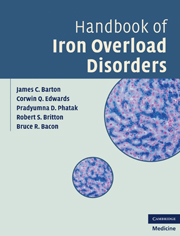Book contents
- Frontmatter
- Contents
- Foreword by Anthony S. Tavill
- Preface
- 1 History of iron overload disorders
- 2 Normal iron absorption and metabolism
- 3 Iron toxicity
- 4 Tests for hemochromatosis and iron overload
- 5 Complications of hemochromatosis and iron overload
- 6 Insulin resistance and iron overload
- 7 Infections and immunity
- 8 Classical and atypical HFE hemochromatosis
- 9 Heterozygosity for HFE C282Y
- 10 Porphyria cutanea tarda
- 11 Mitochondrial mutations as modifiers of hemochromatosis
- 12 Hemochromatosis associated with ferroportin gene (SLC40A1) mutations
- 13 Hemochromatosis associated with hemojuvelin gene (HJV) mutations
- 14 Hemochromatosis associated with hepcidin gene (HAMP) mutations
- 15 Hemochromatosis associated with transferrin receptor-2 gene (TFR2) mutations
- 16 Iron overload associated with IRE mutation of ferritin heavy-chain gene (FTH1)
- 17 Hereditary hyperferritinemia-cataract syndrome: IRE mutations of ferritin light-chain gene (FTL)
- 18 Iron overload in Native Africans and African-Americans
- 19 Hereditary atransferrinemia
- 20 Divalent metal transporter-1 (SLC11A2) iron overload
- 21 Iron overload associated with thalassemia syndromes
- 22 Iron overload associated with hemoglobinopathies
- 23 Iron overload associated with pyruvate kinase deficiency
- 24 Iron overload associated with congenital dyserythropoietic anemias
- 25 Hereditary sideroblastic anemias
- 26 Pearson marrow–pancreas syndrome
- 27 Acquired sideroblastic anemias
- 28 Hereditary aceruloplasminemia
- 29 Friedreich ataxia and cardiomyopathy
- 30 Pantothenate kinase (PANK2)-associated neurodegeneration
- 31 Neuroferritinopathies
- 32 GRACILE syndrome
- 33 Neonatal hemochromatosis
- 34 Iron overload due to excessive supplementation
- 35 Localized iron overload
- 36 Management of iron overload
- 37 Population screening for hemochromatosis
- 38 Ethical, legal, and social implications
- 39 Directions for future research
- Index
- Plate section
- References
26 - Pearson marrow–pancreas syndrome
Published online by Cambridge University Press: 01 June 2011
- Frontmatter
- Contents
- Foreword by Anthony S. Tavill
- Preface
- 1 History of iron overload disorders
- 2 Normal iron absorption and metabolism
- 3 Iron toxicity
- 4 Tests for hemochromatosis and iron overload
- 5 Complications of hemochromatosis and iron overload
- 6 Insulin resistance and iron overload
- 7 Infections and immunity
- 8 Classical and atypical HFE hemochromatosis
- 9 Heterozygosity for HFE C282Y
- 10 Porphyria cutanea tarda
- 11 Mitochondrial mutations as modifiers of hemochromatosis
- 12 Hemochromatosis associated with ferroportin gene (SLC40A1) mutations
- 13 Hemochromatosis associated with hemojuvelin gene (HJV) mutations
- 14 Hemochromatosis associated with hepcidin gene (HAMP) mutations
- 15 Hemochromatosis associated with transferrin receptor-2 gene (TFR2) mutations
- 16 Iron overload associated with IRE mutation of ferritin heavy-chain gene (FTH1)
- 17 Hereditary hyperferritinemia-cataract syndrome: IRE mutations of ferritin light-chain gene (FTL)
- 18 Iron overload in Native Africans and African-Americans
- 19 Hereditary atransferrinemia
- 20 Divalent metal transporter-1 (SLC11A2) iron overload
- 21 Iron overload associated with thalassemia syndromes
- 22 Iron overload associated with hemoglobinopathies
- 23 Iron overload associated with pyruvate kinase deficiency
- 24 Iron overload associated with congenital dyserythropoietic anemias
- 25 Hereditary sideroblastic anemias
- 26 Pearson marrow–pancreas syndrome
- 27 Acquired sideroblastic anemias
- 28 Hereditary aceruloplasminemia
- 29 Friedreich ataxia and cardiomyopathy
- 30 Pantothenate kinase (PANK2)-associated neurodegeneration
- 31 Neuroferritinopathies
- 32 GRACILE syndrome
- 33 Neonatal hemochromatosis
- 34 Iron overload due to excessive supplementation
- 35 Localized iron overload
- 36 Management of iron overload
- 37 Population screening for hemochromatosis
- 38 Ethical, legal, and social implications
- 39 Directions for future research
- Index
- Plate section
- References
Summary
Pearson marrow–pancreas syndrome (OMIM #557000) is an uncommon, heterogeneous disorder caused by deletions or duplications of mitochondrial DNA (mtDNA). First reported in 1979, this disorder presents in neonates or infants and is characterized by refractory sideroblastic anemia with vacuolization of marrow precursors, exocrine pancreatic dysfunction, and metabolic acidosis. Consequent multisystem mitochondrial cytopathy results in inadequate ATP generation for cellular energy requirements and secondary accumulation of iron in mitochondria.
Clinical and laboratory manifestations
Pearson syndrome causes multiple abnormalities that are evident in neonates or infants. Anemia, usually macrocytic, was present in 82% of 55 patients. Typical values of hematocrit are 15%–18%. Some patients have neutropenia or thrombocytopenia. The bone marrow is either normocellular or hypocellular. Ringed sideroblasts are present, and there is vacuolization of marrow erythroblasts and delayed erythroid maturation. Some patients develop splenic atrophy.
Pancreatic exocrine insufficiency was observed in 31% of 55 patients before age 4 years. This results in malabsorption, and thus fat is present in stools. The presence of persistent metabolic (lactic) acidosis suggests that affected patients have a mitochondrial disorder. 3-Methylglutaconic aciduria may be a useful marker for Pearson syndrome. Muscle biopsy may reveal ragged-red fibers that lack cytochrome C, an indicator of abnormal function of the respiratory chain that is typically due to deletions or duplications of mtDNA. Neuroimaging in some patients with Pearson syndrome reveals increased signal intensity over the basal ganglia, brainstem, cerebral hemispheres, or vermis. This is attributed to increased mitochondrial iron retention in these areas of the brain.
- Type
- Chapter
- Information
- Handbook of Iron Overload Disorders , pp. 274 - 276Publisher: Cambridge University PressPrint publication year: 2010



